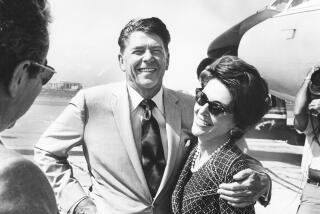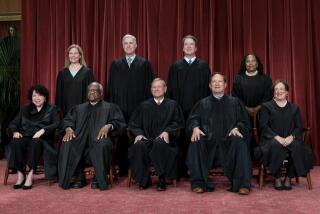CHIEF JUSTICE: A Biography of Earl Warren.<i> By Ed Cray</i> .<i> Simon & Schuster: 604 pp., $30</i>
- Share via
Once upon a time, there was a popular, newly elected politician who made reforming health care his administration’s top priority. His proposal for guaranteeing more Americans health insurance was hardly revolutionary. It preserved the right to choose one’s doctor. It even stopped short of compelling doctors to participate. Still, the doctors hired a firm of clever public relations experts, branded the plan “socialist medicine” and handily defeated the politician’s newfangled experiment with big government.
The man in question was then California Gov. Earl Warren, the year 1945. According to his new biographer, Ed Cray, Warren’s battle to pass a compulsory health insurance bill was every bit the political turning point that a similar battle would become for Bill Clinton 50 years later. The experience, however, sent these two leaders in opposite directions. While Clinton’s health insurance defeat prompted a steady move to the right, Warren’s defeat helped transform a previously conservative governor into the person chiefly responsible for bringing New Deal-style government to California.
“Chief Justice,” the most comprehensive biography of Warren to date, is filled with such latent comparisons to the present day. Indeed, in tracing the arc of Warren’s life--from indifferent student to Oakland district attorney, state attorney general, governor and chief justice of the United States--Cray implicitly invites us to measure the public servants of our time against those of the past.
This is altogether fitting. Warren’s shadow is nearly inescapable on the field of our current political debates. Almost 30 years after his retirement, the battle over the meaning of our Constitution still takes place largely on the terms he set in his 16 years on the court. And one need not accept Cray’s barrage of hagiographic and sometimes banal assessments--”Earl Warren stood as the very embodiment of the American promise”--to agree that reflecting on his career and comparing his accomplishments and personal character against those of our present leadership is to regret that such giant figures are so rare in American public life.
Moving forward through Cray’s chronological portrayal, I was struck by how very often, and sometimes in the face of terrible pressure and vicious criticism, Warren was ahead of the curve on matters both great and small. In more than a decade as California’s governor, from 1942 to 1953, he faced the considerable task of helping the state transform itself from an underdeveloped frontier into a post-war economic powerhouse. Anticipating an explosion in population, social dislocation and opportunity, Warren used his considerable political skills to forge new programs in housing, highways, water and law enforcement. His funding initiatives turned the University of California into the best state educational system in the country, tuition free. He also reformed California’s decrepit prisons, challenged the legality of racially restrictive real estate covenants and, in several other ways, moved to loosen the stubborn hold of Jim Crow attitudes on the West Coast.
Warren’s subsequent achievements on the Supreme Court--the so-called “Rights Revolution”--are both better known and more controversial. But with the benefit of hindsight, it is clear that Warren has gotten much the better of his contemporary critics. With respect to his first, greatest and most resisted achievement--the fashioning of the unanimous opinion in Brown vs. Board of Education to outlaw segregated schools--the world now concedes the correctness of both its result and its spirit.
Similarly, although fellow judges and legal academics became apoplectic when the Warren Court ordered the reapportionment of state legislatures according to the principle of one person, one vote, who but followers of a still-bitter Robert Bork does not now think this a valuable blow for democracy? Even Miranda vs. Arizona, once denounced as a get-out-of-jail-free card for criminals, is now accepted and even applauded by law enforcement.
Under Warren, the court’s main enterprise was to resurrect two promises the country had made to itself after the Civil War: to provide legal equality for blacks and to force often recalcitrant states to observe most of the individual liberties provided in the original Bill of Rights. (Hard as it is to believe, when Warren became chief justice, states did not have to honor such basic rights as having counsel in a criminal trial or not being tried twice for the same crime). Here, Warren was not “inventing” new rights--as those who sought to impeach him charged--but rather enforcing rights the nation had let languish for the better part of a century. This was both good policy and good law.
Beyond these much-to-be-admired substantive accomplishments, Cray’s account of Warren’s personal integrity makes one downright nostalgic. Dean Acheson once said of Warren’s contemporary, Harry Truman, “remembering him reminds people what a man in [high] office ought to be like. It’s character, just character. He stands like a rock in memory now.” The same holds true for Warren.
Throughout his career, from his early days chasing gambling out of Northern California to his confrontations with obstructionist Southern governors after Brown vs. the Board of Education, Warren exerted a moral authority that seems almost mythical from the vantage of our current scandal-ridden politics.
In his private life, Warren was a man of old-fashioned virtue: hard-working, honest, frugal and modest. He remained married to the same woman for 49 years without the slightest hint of infidelity. In his public life, Warren was utterly incorruptible. During almost half a century in public office, he never suffered even the suggestion of financial scandal and, although he fretted constantly about the financial strains imposed by a lifelong career in government, he consistently refused to trade on his public service for private gain.
Before becoming chief justice, Warren was never far from the pressure of having to raise campaign funds. Still, he delighted in turning down money from sources he found objectionable. When Southern California’s “Committee of Sixty-five”--a wealthy group of corporate executives--refused to back his successful 1942 Republican gubernatorial primary campaign, Warren spurned the “moneybags” enthusiastic offer of support for the general election. Instead, he ran on a shoestring and won.
Once he was in office, the moneyed interests whose support Warren had accepted found him remarkably unhelpful in the patronage department. One top contributor, Charles Blyth, approached Warren after his election to put in a private bid on a state bond issue. When Warren told him the issue was going out to public bid, Blyth protested: “You can’t do that. I’ve always had them.”
“Charlie,” Warren allegedly retorted, “you told me you wanted honest, clean government. And that’s what you’re going to get.”
Warren’s unimpeachable persona was crucial to his effectiveness as a leader. His reputation for probity helped develop a popular appeal so broad that in 1946, that he won the governorship as the candidate of both the Democratic and Republican parties. Even at the court, surrounded by personalities as large as his own, Warren’s sheer force of character bent any fractiousness to his will.
As Cray recounts in some detail, through what Eric Severeid called his “gravitas,” Warren imposed on the court a collegial spirit, one that encouraged deliberation, even argument, among the justices but sought to mute those disagreements whenever they threatened the court’s institutional mission. The most famous instance of Warren’s statesmanship is his insistence on a unanimous court for Brown’s world-altering repudiation of “separate but equal” schools. But other examples abound, including the forging of a unanimous court to strike down Virginia’s ban on interracial marriage and Warren’s orchestration of a substantial majority to force the reapportionment of state legislatures.
Here, the contrast with the present is especially striking. Today, the Rehnquist court is deliberately anti-deliberative. Rehnquist actively discourages the justices from exchanging ideas when they meet to decide cases. And he makes no effort to obtain broad consensus (much less unanimity) for the court’s most wide-reaching decisions. Partly as a consequence, the Rehnquist court has been distinguished by disastrously splintered opinions and public name-calling among the justices.
To be sure, Warren’s performance in public office was not flawless. As California’s attorney general, he played a pivotal role in supporting and implementing the shameful decision to intern Japanese Americans during World War II. Although Warren’s initial actions may, perhaps, be excusable as reflecting a general panic after Pearl Harbor, he can be doubly faulted for opposing the release of selected internees as late as 1943. By that time, a year after the decisive American naval victory at Midway, any threat of invasion was long since over; meanwhile, the government still had not produced any evidence of disloyalty among the West Coast’s Japanese immigrants. Yet, having become governor, Warren not only defended the original internment order, he argued to the Supreme Court that continued detention remained a military necessity.
Nor can even a sympathetic observer completely defend Warren’s momentous tenure as chief justice. As many commentators have noted, Warren came increasingly to value the results of his court opinions over their legal logic and can properly be faulted for sometimes failing to provide a durable constitutional foundation to support his broad liberalizing of American law.
Regrettably, Cray does not sufficiently explore Warren’s errors in judgment. He recognizes the contradiction between Warren’s support for internment and his later exuberance for championing racial equality and expanding civil liberties. He also notes some of the standard criticism of Warren, as a chief justice who too often equated what the Constitution required in a given case with his own view of what was “fair.”
What Cray does not offer, however, is a thorough explanation for Warren’s evolution from an anti-New Deal Republican stalwart into the most liberal chief justice in history. Nor does he appraise what remains the baseline question of modern constitutional law: To what degree were the great landmark decisions of the Warren era illegitimate usurpations of power properly vested in the elected branches of government?
Indeed, Cray’s discussion of Warren’s tenure on the court disappoints on many grounds. His treatment of the competing philosophies of such important justices as Felix Frankfurter are grossly oversimplified. (“Felix Frankfurter saw the Supreme Court as a seat of law. Warren saw it as a seat of justice.”) His description of the court’s internal dynamic breaks no new ground and is inaccurate to the extent that Cray considerably understates William Brennan’s role as Warren’s vital partner in shaping the court’s most significant rulings. In all this, Cray is far too much the wide-eyed cheerleader and too little the critic.
But if Cray’s analysis is somewhat lacking, his work is still rich in raw material, and from that material, a coherent portrait of Warren does emerge. It is the portrait of a classically American man, one moved by an intense love of country and a simple faith in its ideals. Guided by these commitments, Warren responded to the changing conditions of his time.
Amid the crisis of the Depression, he shed his attachments to antiquated economic theories and embraced the role of government in helping to create prosperity. Faced with the devastation of Pearl Harbor and the threat of invasion, he sprung to the defense of his country with a zeal that led him astray. And, finally, riding the idealism of America’s post-war boom, the same idealism that would produce the New Frontier and Great Society, Warren refashioned the nation’s basic laws to extend the blessings of its newfound bounty to the full spectrum of its citizenry.
In the 23 years since Warren’s death, our expectations have diminished again. After reading Cray’s rendering of this remarkable man’s life, I cannot help but think that our leaders have diminished with them.
More to Read
Get the L.A. Times Politics newsletter
Deeply reported insights into legislation, politics and policy from Sacramento, Washington and beyond. In your inbox twice per week.
You may occasionally receive promotional content from the Los Angeles Times.









